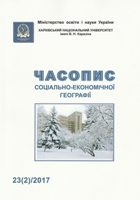Вплив протяжності географічного простору на розподіл міжнародних туристичних потоків
Анотація
У статті висунуте та перевірене припущення, що така властивість географічного простору, як протяжність, впливає на розподіл міжнародних туристичні потоків через відстані між країнами походження і призначення туристів, а також через довжину спільного кодону суходолом, яка у багатьох випадках визначає обсяги туристичного обміну між країнами-сусідами. За результатами аналізу структури міжнародного туризму окремих країн з’ясований характер впливу протяжності географічного простору на географію розподілу міжнародних туристичних потоків. Зокрема, виявлена закономірність, за якою частка прибуттів або вибуттів у структурі міжнародного туризму певної країни може бути будь-якою, але, зазвичай, не перевищує значення, яке із відстанню зменшується за експонентою. Тобто, встановлено, що відстань не визначає, а обмежує інтенсивність туристичного обміну між країнами. Також встановлено, що близько 50% міжнародного туристичного обімну відбувається між країнами-сусідами, а частка країни-сусіда в структурі туристичних прибуттів або вибуттів часто узгоджується з протяжністю спільного кордону суходолом.
Завантаження
Посилання
2. Erina, A.M. (2001). Statystychne modelyuvannya ta prognozuvannya [Statistical modeling and forecasting]. Kyiv: KNEU, 170.
3. Korol, O.D., Skutar T.D. (2008). Mizhnarodnyi turyzm: metodyka i materialy statystychnykh doslidzhen [Interna-tional tourism: methods and materials of statistical research]. Chernivtsi: Ruta, 64.
4. Lyubitseva, O.O. (2003). Rynok turystychnykh posluh [The market of tourist services]. Kyiv: Alterpres, 436 p.
5. Hagerstrand, T. (1970). What about people in regional science? Lund: Springer – Verlag.
6. International tourism: UNWTO Tourism Highlights, 2001-2016 Editions. Available at: http://mkt.unwto.org/publications
7. OECD Tourism Trends and Policies 2010: OECD Publishing (2010). Available at: https://books.google.com.ua/books?id=UC7WAgAAQBAJ
8. Tourism flows outbound (by countries): Euromonitor International (2012). Available at: http://www.euromonitor.com/travel
Авторське право (c) 2017 Олександр Король

Цю роботу ліцензовано за Міжнародня ліцензія Creative Commons Attribution 4.0.




